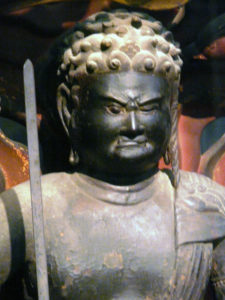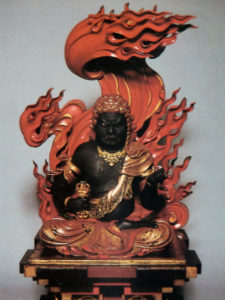
Of the Black people of early Japan, the most picturesque single figure was Sakanouye no Tamuramaro, a warrior symbolized in Japanese history as a “paragon of military virtues,” and a man who has captured the attention of some of the most distinguished scholars of 20th century America.
Perhaps the first such scholar to make note of Tamuramaro was Alexander Francis Chamberlain (1865-1914). An anthropologist, Chamberlain was born in Kenninghall, Norfolk, England, and was brought to America as a child. In April 1911, the Journal of Race Development published an essay by Chamberlain titled The Contribution of the Negro to Human Civilization. While discussing the African presence in early Asia, Chamberlain stated in an exceptionally frank and matter of fact manner:
“And we can cross the whole of Asia and find the Negro again, for when, in far-off Japan, the ancestors of the modern Japanese were making their way northward against the Ainu, the aborigines of that country, the leader of their armies was Sakanouye Tamuramaro, a famous general and a Negro.”
Dr. W.E.B. DuBois (1868-1963), perhaps the greatest scholar in American history, in his book, The Negro (first published in 1915), placed Sakanouye Tamuramaro within a list of some of the most distinguished Black rulers and warriors in antiquity.
In 1922, Carter G. Woodson (1875-1950) and Charles Harris Wesley (1891-?) in a chapter called Africans in History with Others, in their book, The Negro in Our History, quoted Chamberlain on Tamuramaro verbatim. In the November 1940 issue of the Negro History Bulletin (founded by Dr. Woodson), artist and illustrator Lois Maillou Jones (1905-1998) contributed a brief article titled Sakanouye Tamura Maro.
In the article Jones pointed out that:
“The probable number of Negroes who reached the shores of Asia may be estimated somewhat by the wide area over which they were found on that continent. Historians tell us that at one time Negroes were found in all of the countries of southern Asia bordering the Indian Ocean and along the east coast as far as Japan. There are many interesting stories told by those who reached that distant land which at that time they called `Cipango.’
One of the most prominent characters in Japanese history was a Negro warrior called Sakanouye Tamura Maro.”
Very similar themes were expressed in 1946 in In the Orient, the first section of Distinguished Negroes Abroad, a book by Beatrice J. Fleming and Marion J. Pryde in which was contained a small chapter dedicated to “The Negro General of Japan — Sakanouye Tamuramaro.”

In 1940, the great Joel Augustus Rogers (1883-1966), who probably did more to popularize African history than any scholar of the 20th century, devoted several pages of the first volume of his book, Sex and Race to the Black presence in early Japan. He cites the studies of a number of accomplished scholars and anthropologists, and even goes as far as to raise the question, “Were the first Japanese Negroes?” In the words of Rogers:
“There is a very evident Negro strain in a certain element of the Japanese population, particularly those in the south. Imbert says, ‘The Negro element in Japan is recognizable by the Negroid aspect of certain inhabitants with dark and often blackish skin, frizzly or curly hair. … The Negritos are the oldest race of the Far East. It has been proved that they once lived in Eastern and Southern China as well as in Japan where the Negrito element is recognizable still in the population.'”
Rogers mentioned Tamuramaro briefly in the first volume of World’s Great Men of Color, also published in 1946. Regrettably, Rogers was forced to confess that “I have come across certain names in China and Japan such as Sakonouye Tamuramaro, the first shogun of Japan, but I did not follow them up.”
Sakanouye Tamuramaro was a warrior symbolized in early Japanese history as a “paragon of military virtues.” Could it be that this was what Dr. Diop was alluding to in his first major book, Nations negres et culture, when he directed our attention to the tantalizing and yet profound Japanese proverb: “For a Samurai to be brave he must have a bit of Black blood.”
Adwoa Asantewaa B. Munroe referenced Tamuramaro in the 1981 publication What We Should Know About African Religion, History and Culture, and wrote that “He was an African warrior. He was prominent during the rule of the Japanese Emperor Kwammu, who reigned from 782-806 A.D.” In 1989, Dr. Mark Hyman authored a booklet titled Black Shogun of Japan in which he stated that “The fact remains that Sakanouye Tamuramaro was an African. He was Japanese. He was a great fighting general. He was a Japanese Shogun.”
However, the most comprehensive assessment to date of the Black presence in early Japan and the life of Sakanouye no Tamuramaro is the work of art historian and long-time friend and colleague Dr. James E. Brunson. Brunson is the author of Black Jade: The African Presence in the Ancient East and several other important texts. In a 1991 publication titled The World of Sakanouye No Tamuramaro, Brunson accurately noted that “In order to fully understand the world of Sakanouye Tamuramaro we must focus on all aspects of the African presence in the Far East.”
Sakanouye no Tamuramaro is regarded as an outstanding military commander of the early Heian royal court. The Heian Period (794-1185 C.E.) derives its name from Heian-Kyo, which means “the Capital of Peace and Tranquility,” and was the original name for Japan’s early capital city — Kyoto. It was during the Heian Period that the term Samurai was first used. According to Papinot, the “word comes from the very word samuaru, or better saburau, which signifies: to be on one’s guard, to guard; it applied especially to the soldiers who were on guard at the Imperial palace.”
The samurai have been called the knights or warrior class of Medieval Japan and the history of the samurai is very much the history of Japan itself. For hundreds of years, to the restoration of the Meiji emperor in 1868, the samurai were the flower of Japan and are still idolized by many Japanese. The samurai received a pension from their feudal lord, and had the privilege of wearing two swords. They intermarried in their own caste and the privilege of samurai was transmitted to all the children, although the heir alone received a pension.
The “paragon of military virtues,” Sakanouye no Tamuramaro (758-811) was, in the words of James Murdoch:
“In as sense the originator of what was subsequently to develop into the renowned samurai class, he provided in his own person a worthy model for the professional warrior on which to fashion himself and his character. In battle, a veritable war-god; in peace the gentlest of manly gentlemen, and the simplest and unassuming of men.”
Throughout his career, Tamuramaro was rewarded for his services with high civil as well as military positions. In 797 he was named “barbarian-subduing generalissimo” (Sei-i Tai-Shogun), and in 801-802 he again campaigned in northern Japan, establishing fortresses at Izawa and Shiwa and effectively subjugating the Ainu.
In 810 he helped to suppress an attempt to restore the retired emperor Heizei to the throne. In 811, the year of his death, he was appointed great counselor (dainagon) and minister of war (hyobukyo).
Sakanouye no Tamuramaro “was buried in the village of Kurisu, near Kyoto and it is believed that it is his tomb, which is known under the name of Shogun-zuka. Tamuramaro is the founder of the famous temple Kiyomizu-dera. He is the ancestor of the Tamura daimyo of Mutsu.” Tamuramaro “was not only the first to bear the title of Sei-i-tai-Shogun, but he was also the first of the warrior statesmen of Japan.”
In later ages he was revered by military men as a model commander and as the first recipient of the title shogun — the highest rank to which a warrior could aspire.”
http://atlantablackstar.com/2014/09/...f-early-japan/






Comment